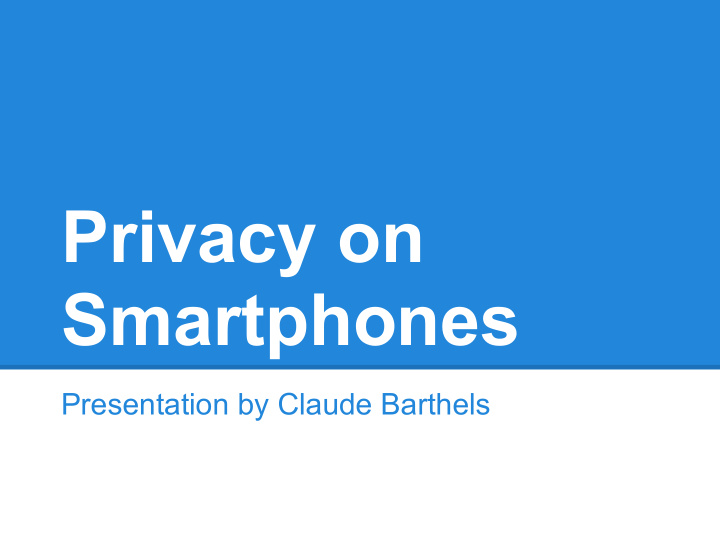



Privacy on Smartphones Presentation by Claude Barthels
Roadmap ■ TaintDroid: An Information-Flow Tracking System for Realtime Privacy Monitoring on Smartphones ■ MockDroid: Trading Privacy for Application Functionality on Smartphones ■ Paranoid Android: Versatile Protection for Smartphones
TaintDroid An Information-Flow Tracking System for Realtime Privacy Monitoring on Smartphones Paper by W. Enck, P. Gilbert, B.-G. Chun, L. P. Cox, J. Jung, P. McDaniel, A. N. Sheth
Problem Setting ?
What is TaintDroid? Extension of the Android platform Tracks flow of information through an application Realtime analysis & feedback Tracks data between processes (file, IPC, ...)
General idea Mark (taint) sensitive information Taint sources and sinks Sensitive Information Tainted Information Application if (taint == true) Taint Source Taint Sink ALERT!
Design Challenges Limited resources & performance Identifying private information Multiple types and sources of sensitive data Data sharing between applications
User notification
How it works - Variable level Multiple taint markings stored in a taint tag Taint tag is a 32bit vector Stored adjacent to the variables Only one taint tag per array
How it works - Stack layout
How it works - Message & file level Only one tag per message or file Union over all taint tags of the variables contained in the message or file Potential for false positives Less overhead than a finer granularity
How it works - Propagation logic
Where to place taint sources & sinks? Low-bandwidth sensors (location, accelerometer, ...) High-bandwidth sensors (camera, microphone, ...) Information databases (calendar, address book, ...) Device identifiers (SIM number, IMEI number, ...) Network Taint Sink
Limitations Data flow tracking only / No control flow tracking Native code is unmonitored ○ Conservative heuristic: Assign union of argument taint markings to return type Sometimes too coarse grained ○ One taint tag per message or file ○ One taint tag per array
Performance
Experiment - Setup 30 popular applications ~ 100 minutes of recording Network access + additional permissions Nexus One with Android 2.1
Experiment - Applications
Experiment - Results
Reviews 6 Reviews - Average Score 2.16 (accept) + Privacy is an issue (Data scandal is a matter of time) + Low overhead / Good performance - accuracy tradeoff +/- Study with open source software as ground truth +/- A lot of implementation details - No native code tracking or static code analysis - A lot of Android knowledge required - Too sophisticated for 'normal' user - May force developers to create new malicious ways to get the data - Only notifications / No control
MockDroid Trading Privacy for Application Functionality on Smartphones Paper by A. R. Beresford, A. Rice, N. Skehin, R. Sohan
Problem setting Similar problem setting as TaintDroid Applications often require sensitive data to work correctly Access to resources is granted once at install time and cannot be changed afterwards
What is MockDroid? Extension of the Android platform MockDroid allows to fake (mock) sensitive data Decision of faking data can be done/changed at runtime
What is MockDroid?
How it works Granted permissions are stored by Android in an in- memory data structure and on disk API calls check the in-memory data structure MockDroid extends the data structure with a 'real' and a 'mocked' version of the permission Internet permissions requires inet group. MockDroid therefore adds a mocked_inet group
What can be faked? Location - no location fix Internet - connection timeout Calendar & contacts - empty database - zero rows affected Device id - Fake constant value Broadcast intents - Intents never sent/received
Limitations Limited in what can be faked ○ Instead of no location, just an approximate indication (e.g. next big city) ○ Instead of empty contact or calendar database, MockDroid could return a subset (like public events)
Evaluation Local ○ location used for location based advertisements ○ No reduced functionality Internet: ○ Limited functionality when mocking internet access ○ Continue to run even without internet access
Paranoid Android Versatile Protection for Smartphones Paper by G. Portokalidis, P. Homburg, K. Anagostakis, H. Bos
Problem setting Smartphones hold privacy sensitive information Become highly valuable targets for attacks Security solutions from PCs are not always applicable to smartphones
What is Paranoid Android? Security as a service Security checks are performed by security servers Security servers hold an exact replica of the phone in a virtual environment Record & replay model
Overall architecture
Security Model Buffer overflows & Code injection (implemented in prototype) Open source AntiVirus scanner (for file scans) (implemented in prototype) Memory scanner for patterns of malicious code Abnormal system call detection ... flexible model which can be extended
Notification & Recovery Notifications, Emails or SMS may be blocked Hardware support Restore to clean state using the replica Minimizing data loss
Evaluation Amount of trace data Overhead of the tracer Performance and scalability of the server
Evaluation - Amount of trace data
Evaluation - Overhead
Evaluation - Server scalability
Questions & Discussion ■ Which approach do you like most? Or other ways to protect privacy? ■ Will it become a necessity to run AV software on a phone? ■ Has anyone installed an AV already? ■ What is a better approach: restricted platforms like iOS or more open platforms like Android? Thank you very much for your attention!
Recommend
More recommend